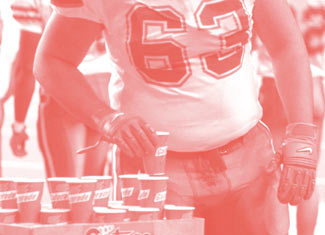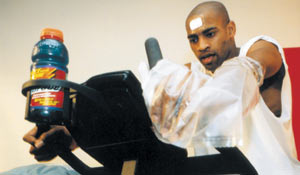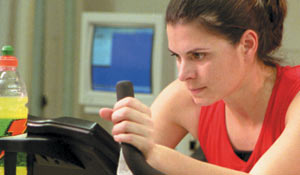|
by
Joe Kays & Arline Phillips–Han
Gatorade’s current slogan
asks “Is it in you?” But 38 years ago, it was what was coming
out of University of Florida football players that prompted the question
that launched an industry. In a world where teams at all levels of competition
spare no expense in applying modern technology to enhance performance,
it’s hard to imagine a time when athletes were discouraged from
drinking even water for fear it would cause nausea and cramps.
In hindsight, the risks seem
obvious, but at the time they weren’t, until a spring day in 1965
when then-assistant Gator football coach Dwayne Douglas questioned UF
kidney disease specialist Robert Cade about why players lost so much weight
during practices and games but urinated so little. Douglas, who had a
stellar career with the Gators and then the NFL’s Philadelphia Eagles
until he injured his knee, told Cade he had lost as much as 18 pounds
during a game, but never felt the need to visit the restroom.
Cade, who then directed the
UF College of Medicine’s renal and electrolyte division, quickly
deduced that the players were sweating so much they didn’t have
any fluids left to urinate. But it was the underlying questions that intrigued
him more.
“It’s obvious
why, but it’s just not the kind of thing I went around giving great
periods of thought to,” Cade once told a reporter. “That question
changed our lives.”
After his conversation with Douglas, Cade began to give plenty of thought
to the problem. And he got his research fellows — Dana Shires, Jim
Free and A.M. deQuesada — to start thinking about it also.
As they researched the effects of heat on the human body, Cade and his
colleagues began to realize that all that sweat was taking with it the
players’ energy, strength and endurance. The researchers speculated
that the electrolytes — primarily sodium and potassium — the
players were losing in their sweat were upsetting the body’s delicate
chemical balance.
To test their hypothesis,
Cade approached then-Gator football coach Ray Graves about letting him
use several players as subjects. “One of the reasons I have respect
for Coach Graves was that when we explained to him what we had found he
professed no ability to really understand what we were saying, but he
accepted it,” Cade recalled in an interview he gave in 1996 for
the UF Oral History Project. “But he hedged his bets a bit. He said
we could try it only on the freshman team.”
In early September 1965 Cade
and his colleagues began collecting all manner of samples from 10 UF freshmen
football players. They were most cooperative, Cade once told a reporter,
but they had their limits.
“They would not consent
to having practice stopped so we could measure their body temperatures
rectally,” Cade recalled.
The results were eye-opening.
The players’ electrolytes were completely out of balance, their
blood sugar was low and their total blood volume was low. The impact on
the body of this upheaval in chemistry was profound.
“Each of these conditions,
by itself, would to some extent incapacitate a player,” Cade says
in his oral history. “Put them all together and you can have real
problems.”
With hard data in hand, Cade’s
team began pursuing a remedy to address all these issues.
“The solution,”
Cade says, “was to give them water, but with salt in it to replace
the salt they were losing in sweat. Also, give them sugar to keep their
blood sugar up, but not so much sugar that it would upset their stomachs.”
By all accounts, the first
batch tasted so bad none of the scientists could stomach it, but when
Cade’s wife suggested adding lemon juice, the drink that would soon
become known as Gatorade was born.
According to legend, the first on-the-field tests of Gatorade came in
a scrimmage between the Gators B team and the freshmen.
“At the end of the first
half, the B team was ahead 13-0. They pushed the freshmen around pretty
good,” Cade says. “In the third period, the freshmen, who
had been given the solution, came out and began pushing the B team around.
They scored two or three touchdowns in the third period and five or six
more in the fourth period.”
Cade says Graves witnessed
the turnaround and was impressed enough to ask him if he could make up
a supply for the varsity to use the next day in its game against heavily
favored Louisiana State.
Cade and his colleagues worked
through the night, scavenging their labs for the ingredients and hand-squeezing
lemons.
The next day, Florida came
from behind to defeat LSU in 102-degree heat when the Tigers wilted in
the fourth quarter.
Cade’s team continued
to tinker with their concoction and by the beginning of the 1966 season
Gatorade, as it was now called, had become a staple on the Gators’
sideline. After the first scrimmage that August, seven Gator players were
brought to the Shands Hospital emergency room with heat-related illnesses.
The next day, 17 players went to the hospital and eight were admitted.
Deeply concerned, Graves asked Cade for enough Gatorade to keep all players
supplied during both practice and games. Over the next five years, only
one player
 had
to be hospitalized for treatment of a heat-related illness. Turns out,
he had not drunk any Gatorade. had
to be hospitalized for treatment of a heat-related illness. Turns out,
he had not drunk any Gatorade.
The
Gators rolled to an 8-2 record in 1966, earning a reputation as a second-half
team, and after a season-ending victory over the University of Miami a
reporter for the Miami Herald scored an interview with Graves where the
coach talked about the beneficial effects of Gatorade. The story about
the sports drink went out on the Associated Press and United Press International
wires and, in Cade’s words, “Our stuff was on its way.”
The
university released an official statement about Gatorade in late December
1966 that the Florida Times-Union summed up with this headline:
“One Lil’ Swig of That Kickapoo Juice and Biff, Bam, Sock
— It’s Gators, 8-2.”
In
1967, one of Cade’s research fellows took a job at Indiana University,
where he told a vice president for Indianapolis-based Stokely-Van Camp
Co. about Gatorade. By that fall, Stokely-Van Camp had secured rights
from Cade and his fellow inventors to begin marketing Gatorade nationwide.
Soon,
Stokely-Van Camp was selling hundreds of thousands of gallons of Gatorade
annually and interest in ownership rights grew. The next few years were
marked by a series of legal disputes that were ultimately settled in 1973
so that both the University of Florida and the original inventors —
organized as the Gatorade Trust — received royalties.
In
1983, the Quaker Oats Co. purchased Stokely-Van Camp and, as UF marketing
Professor Richard Lutz describes it, “launched Gatorade from a sleepy
little brand into superstardom.”
Drawing
on its vast marketing resources and utilizing the talents of arguably
the world’s most famous athlete — Michael Jordan — Quaker
Oats was able to secure more than 80 percent of the sports beverage market
for Gatorade. Since 1983, Gatorade has enjoyed an unprecedented 20 percent
annual sales growth rate, from about $100 million in 1983 to more than
$2.2 billion in 2001. Pepsico purchased Quaker Oats in 2001, a move beverage
industry analysts predict will eventually lead to an even greater share
of the market for Gatorade.
“Over
the years, royalties from Gatorade and a host of other products
has enabled the University of Florida to invest in countless research
projects in a wide variety of disciplines.”
–Win Phillips, UF Vice President for
Research
|
For
the University of Florida, the success of Gatorade has translated into
more resources to support research. Since 1973, Gatorade has brought more
than $80 million to the university, which has been used to fund everything
from UF’s Whitney Marine Laboratory in St. Augustine to the on-campus
Genetics Institute.“
Over
the years, royalties from Gatorade and a host of other products has enabled
the University of Florida to invest in countless research projects in
a wide variety of disciplines,” says Win Phillips, UF’s vice
president for research. “Often, Gatorade revenue has provided ‘seed
money’ for projects that offered great potential but were still
in the developmental stage. Many of these projects went on to win competitive
national grants, recouping the university’s investment in them many
times over.”
Shortly
after it acquired Stokely-Van Camp, Quaker Oats began taking steps to
nurture Gatorade’s scientific pedigree by creating the Gatorade
Sports Science Institute. At the institute’s laboratories outside
Chicago, a team of scientists “study a wide range of physiological,
biochemical and sensory responses to nutrition, exercise and the environment,”
says institute Director Robert Murray on the institute’s website.
“The
Gatorade formula has changed very little over the years,” Murray
says, “which is remarkable since Gatorade is the most researched
sports drink on the planet.”
The
company maintains that its formula of carbohydrates (sucrose, glucose
and fructose) and electrolytes (potassium and sodium) is the optimal mixture
for stimulating fluid absorption, helping the body maintain fluid balance,
providing energy to working muscles and enhancing athletic performance.
Among
the scientists on the Gatorade Sports Science Institute’s board
of external advisers is UF exercise physiology Professor Scott Powers,
director of the university’s Center for Exercise Science and chair
of the Department of Exercise and Sports Science.
Powers
says the Gatorade Sports Science Institute has a “relentless attitude
toward sports nutrition research” that applies to both Gatorade
and other sports-nutrition products manufactured by the company.
To
achieve a world-class level of sports-nutrition research, Powers says
the Gatorade Sports Science Institute employs numerous full-time exercise
and nutritional scientists and also collaborates with researchers from
universities worldwide.
“This research effort makes Gatorade the most extensively researched
sports-nutrition product on the market,” Powers says.
Outside
the sports arena, Gatorade has filled an important niche in medicine —
a contribution UF College of Medicine Dean C. Craig Tisher says deserves
headlines of its own.
“The
ingestion of Gatorade by athletes at all levels of competition, as well
as by ‘weekend warriors’ — especially under conditions
of extreme heat and humidity — has undoubtedly prevented countless
episodes of heat stress and heat stroke,” Tisher says. “Further,
the use of Gatorade in medical conditions associated with extreme dehydration,
such as diarrheal diseases and other causes of volume depletion, offers
the medical community a relatively simple and inexpensive way to manage
conditions that are often life-threatening.”
 |
 |
THE
ATHLETES:
Soccer star Mia Hamm and basketball
player Vince Carter are tested at the Gatorade Sports Science Institute
laboratories.. |
Cade, the inventor, is an award-winning
medical teacher and productive scientist whose eclectic interests range
from playing the violin to reading and writing poetry, growing roses and
restoring and showing antique Studebaker cars. It is his love of learning,
however, that still attracts him five days a week to his laboratory. At
75, the idea of retirement is out of sync with the excitement he finds
in the process of discovery.
His
latest research interest is the result of several years studying children
with autism, Down’s syndrome and certain types of schizophrenia,
in whom he has identified a problem that may underlie the intellectual
deficits associated with all three diseases. Cade found these children
develop excess amounts of morphine-like compounds derived from casein
in milk and gliadin from grains. He determined that because the patients
are unable to digest these compounds properly, chains of amino acid remain
in the brain where they transmit false signals.
Based
on his findings, Cade says, “It seems possible that we might be
able to reverse or at least minimize the adverse effects on intellectual
function by putting the youngsters on a diet free of casein and gliadin.”
Cade’s hypothesis, which he plans to investigate through clinical
trials, has a strong precedence. In earlier studies of children with autism,
he developed and demonstrated the effectiveness of a diet free of glutein,
casein, milk and grain products. The diet, now applied worldwide, helps
about 80 percent of patients improve dramatically or recover completely.
Cade
says his most gratifying career accomplishment is Gatorade, but adds,
“If this new dietary treatment I’m working on turns out to
be beneficial to children with autism, Down’s syndrome and schizophrenia,
I may think this is greater than Gatorade.”
“Throughout
his 41-year career at UF, Dr. Cade has manifested the unique combination
of a practical dreamer and a creative scientist,” says Tisher. “His
insatiable curiosity has always been channeled to discover ways to help
his fellow man. Although many would point to the development of Gatorade
as his greatest achievement, I would submit that his willingness to share
his knowledge and good fortune often with complete strangers best defines
his success.”
|

